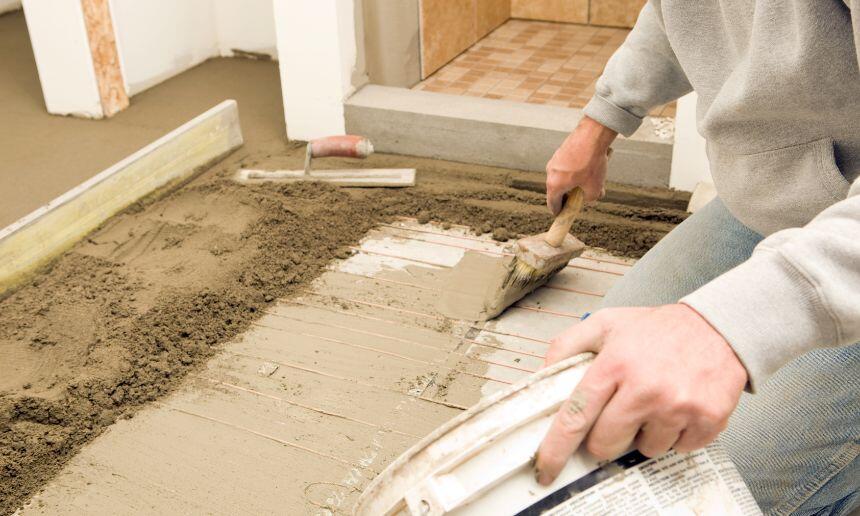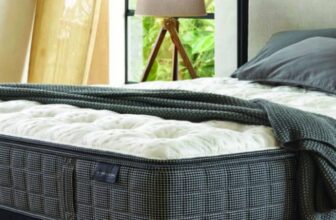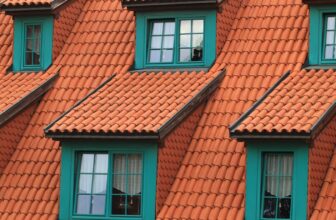Is Thinset Waterproof? Exploring its Capabilities
One of the most popular mortar types, thinset is specifically designed to adhere tiles to walls.
It’s typically made of sand, cement, and water retention agents and is available either as a dry powder or in pre-mixed form.
The main difference between thinset and other kinds of mortars and adhesives is that it’s, as its name says, thinner, which makes it easier to spread across the surface with a high degree of uniformity.
However, this also means that it lacks strength and is unsuitable for other uses, such as holding stacked bricks in place and building walls.
So, as it exclusively works as a tile adhesive, thinset is primarily used in bathrooms and other spaces featuring tiles.
As tiles are typically used in moist environments, this raises the question is thinset waterproof and can it withstand the humidity and water it will be exposed to in bathrooms, kitchens, or patios.
In this article, I’ll explore the characteristics of thinset and answer the question of whether or not it’s waterproof.
So, let’s dive in!
Table of Contents
Is Thinset Waterproof?

Thinset is waterproof, which means that you can freely use it as a tile adhesive in bathrooms or kitchens.
Thinset is probably your best option for these purposes, as it handles water much better than mastic or other adhesives.
By using thinset, you’ll ensure that the tiles will remain intact in their place, even in spaces that are frequently exposed to a lot of water, such as shower cabins.
Plus, thinset is also mold-resistant, so you can rest assured that it will not deteriorate over time like some other adhesives.
However, you should be aware that thinset will be waterproof only when used properly.
This means that you have to apply it rather quickly and evenly and then allow enough time for thinset to set and cure.
While there will be no issues with cured thinset getting wet, exposing it to moisture before it’s fully dry will negatively impact its effectiveness.
How Long Does It Take for Thinset to Cure?
When applying thinset, you will have to give it some time to dry.
How long it will take will depend on several factors, but commonly, it should be ready in 24 to 48 hours.
Note that different types of thinset will not take the same time to cure as their ingredients may slightly differ.
Also, it’s important to know that you shouldn’t allow thinset to become too dry before applying it to the surface, as it will not hold the tiles that well and may be uneven.
Below is a short overview of the major factors that determine how much time it will take for thinset to dry.
Temperature
Logically, higher temperatures will speed up the drying process, while a colder environment will slow it down.
However, it’s best to let the thinset cure at a fairly moderate temperature as too much heat will cause it to dry out too quickly before it achieves the desired strength.
On the other hand, a temperature that is too low may significantly prolong the curing period.
Typically, any temperature below 40 degrees Fahrenheit will mean that thinset will need more than 24 hours to cure.
In any case, you can speed up the process a bit by using curing blankets.
Air Circulation
No matter what the temperature is, thinset will hardly be able to cure properly without good ventilation.
Proper airflow will reduce the amount of moisture in the environment and allow thinset to cure more quickly.
Poor circulation will not only prolong the drying period but can also result in mold and mildew development.
Still, make sure that all the air circulation is natural, as overdoing it, for example by using fans, will dry the mixture too quickly and make reduce the strength of thinset and its ability to hold tiles.
Water and Humidity
Of course, water and humidity play a critical role in the thinset curing process.
Too much moisture in the mixture will increase the time needed for thinset to properly dry, while too dry of a mixture may not provide the optimal strength and adhesive power.
When mixing the thinset, the optimal amount of water is between 5 and 7 percent.
Also, the curing process is affected by the humidity of the environment. Logically, an area that is too humid will cause thinset to dry faster and vice-versa.
You should look to keep the humidity level between 40 and 60 percent during the curing process.
Type of Thinset
There are two basic types of thinset – modified and unmodified.
Unmodified thinset typically only contains cement, sand, and water-retaining agents, while the modified type also features acrylic or liquid latex polymers, and in some cases, chemical-resistant agents.
These are added to increase the bond strength but they also prolong the period needed for the curing process to be completed.
Can You Use Thinset Outside?
One of the advantages of thinset is that it can also be used for outside applications, such as installing tiles on patios or similar areas.
However, when using thinset outside, you’ll need to make sure that you have the right type, as these areas will be exposed to weather elements, so the regular thinset won’t do.
You’ll need to use a modified thinset, with additives that make it more resistant to these conditions and capable of keeping its strength longer.
Another thing to keep in mind is that when using thinset outside, it will take longer to cure, especially if you live in an area with a dry and windy climate.
Conclusion
Thinset is a great option when installing tiles in an area that is going to be exposed to a lot of moisture.
Thanks to its water-resistant properties, this type of adhesive works great in bathrooms, kitchens, or any other space where the tiles will be exposed to excess humidity.
Plus, it will help in preventing mold and mildew development.
Still, to make sure your tiles are secure and that the thinset will do its job, you’ll need to carefully follow instructions on how it should be applied and allow it enough time to properly cure.
Otherwise, it may not be efficient, as it will neither hold the tiles well nor absorb the water the way it’s supposed to.



















































































